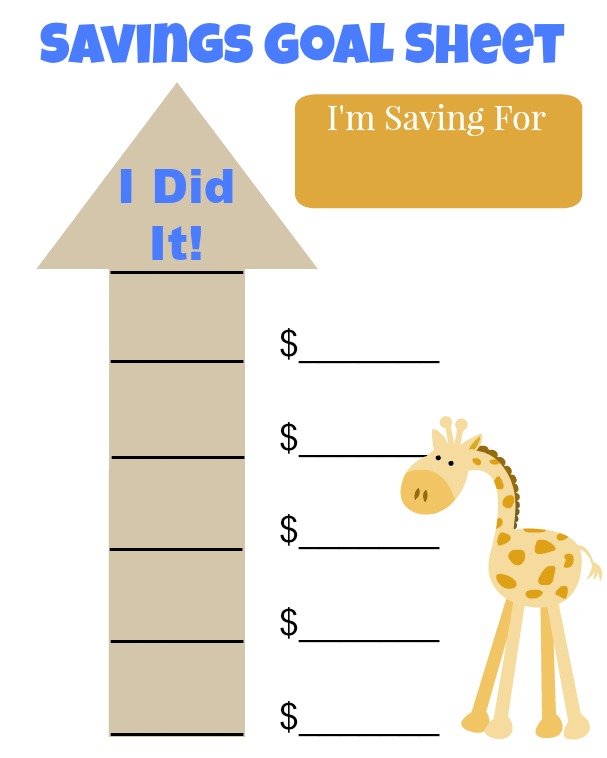I wrote a post about Teaching Kids about Finances a while back but I thought now would be a good time to discuss a few more ways you can teach kids to manage money and live financially smart lives. Let’s face it, finances isn’t one of those really easy things to discuss as a family. I didn’t really know much about my family’s finances growing up. I have a few suggestions for you to help children have a better understanding of finances at their age level and how it can be discussed easily in an everyday setting.
Don’t miss the Savings Goal Sheet towards the bottom of this post. Print it out for a fun way to help your kids track their savings.
Teaching Kids to Manage Money
1- Be a Role Model We all know that children follow our example so we need to practice what we preach, which means living within our means and being honest about our finances and financial goals. We all want a better life for our children including financially so we need to give them a good example and an honest look at finances. Making a budget and sticking to it is probably one of the best examples.
2- Give a Modest Allowance I believe in giving my children an allowance and allowing them to govern their money, of course this means they have responsibilities to fulfill to receive that money. They are learning that money isn’t just given to them and that they need to earn it. This seems to make them a lot more careful in how they spend their money also. They have become a lot better at saving for what they really want instead of spending a dollar here and a dollar there on things they don’t really care about.
3- Shop with Your Children Take your children grocery shopping, clothes shopping, and even car shopping. Discuss price differences, how much is in the budget for a certain item, and even if you should wait until you save more money before you make the purchase. When they see you making these decisions daily it becomes part of their life and they tend to continue to follow your example. Along with that teach them that you won’t buy them everything they want, teach them the difference between a want and a need, and teach them that it’s okay to wait to purchase something.
4- Share Financial Information Tell your children stories of when you didn’t plan financially or when you were in tough times or even when you planned financially and everything turned out well. Tell them the good, the bad, and the ugly. Of course we’ve all made mistakes, but our children can learn from our financial mistakes. It’s hard to let your children know that maybe they can’t participate in something because of the cost, but by sharing the family finances they get a better understanding of money and if they’re older they might be able to find a way to contribute to the cost of the event.
5- Value a Good Education We often discuss how education will effect their financial security as an adult. They have researched the pay scale of different careers that interest them and how much college education they will need to achieve their goals. Setting up a college savings account is a great idea and it is never too early to start. Also don’t overlook all of the many scholarship opportunities out there.
6- Play a Game Playing the Game of Life might seem like a weird way to teach your kids about finances but it’s the perfect learning tool. The game is full of decisions and life choices, the expected and unexpected, and the perfect time to discuss real life situations. They’re having fun but they’re also learning that babies cost money, an education is important, that you have to have a home to live in, and unexpected things happen that can be hard if you haven’t done your best to prepare.
I made a Savings Goal Sheet you can print out and use to help your kids reach a savings goal. Just click on the title below the image, right click to save it to your computer, then you can size it to whatever size you like.
Bear with me a little longer because the last thing I want to share with you is some information I found to be very valuable to help children understand finances at every age. There are 20 important things listed to help them live responsible financial lives as they’re growing up and as adults.
3-5 Years
1- You need money to buy things.
2- You earn money by working.
3- You may have to wait before you can buy something you want.
4- There is a difference between things you want and things you need.
6-10 Years
5- You need to make choices about how to spend your money.
6- You should shop around and compare prices before you buy.
7- It can be costly and dangerous to share information online.
8- Putting your money in a savings account will protect it and pay you interest.
11-13 Years
9-You should save at least a dime for every dollar you receive.
10- Entering personal information like a credit card number online could be risky.
11- The sooner you save, the faster your money can grow from compound interest.
12- Using a credit card is like taking out a loan. If you don’t pay it back every month, you’ll be charged interest.
14-18 Years
13- Compare cost of colleges.
14- You should avoid using credit cards to buy things you can’t afford to pay for with cash.
15- Your first paycheck will be smaller than expected because of taxes being taken out.
16- A good place to save and invest money is in a Roth IRA.
18+ Years
17- You should use a credit card only if you can pay off the money owed in full each month.
18- You need medical insurance
19-It’s important to save at least 3 months worth of living expenses in case of an emergency.
20- When investing consider the risks and annual expenses.
I hope this has been helpful to you in your desire to teach your kids about managing money.
Pin it for later:

You might also like these posts:












Great post, Leanne! I love the goal sheet!!
Excellent tips and the printable is so cute!!!
Laura
Thank you for such useful tips and great printable!
Such great tips! Thanks so much for sharing!!
Thanks for such a helpful article! Thanks to you, I learned a lot!
I especially liked the idea of Playing the Game of Life. Pinned!